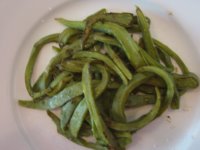Ever since I first read him in high school, I haven't been able to generate much passion for grumpy old Stephen Crane.
Case in point:
A man said to the universe:
"Sir, I exist!"
"However," replied the universe,
"The fact has not created in me
A sense of obligation." - Crane
How come the universe has to be so pedantic? I prefer mine warm and breezy, with a slight chance of showers.
It occurs to me that you could rewrite the above poem, substituting the word "google" for "the universe."
Or the words "the Bronx."
Or the words, "3:15 pm bus crowded with people on their cell phones and yelling, hormonal teenagers recently released from captivity."
Yep, I think that pretty much fits.
Wednesday, November 29, 2006
Wednesday, November 08, 2006
Libary Thrills
In the farthest reaches of the New York Public Library is a little room called the "Special Collections Division." I went there today, all the while thinking of it as the “Special Victims Unit.” It’s where the exciting books live, sheltered and climate controlled, under the care of serious, winged librarians whose footfall echoes not.
I needed a book there, and I had to go through yards of paperwork to get it. As I was signing forms, I asked one of the librarians why this particular book (essays by a 19th century New York City journalist) was held under lock and key. He explained that it was part of a private collection of one Mr. George Arants, a successful tobacco executive, who spent most of his adult life amassing books, magazines and advertisements dealing with tobacco. The man apparently loved smoking.
The journalist I was researching (one Fanny Fern) was not, to my knowledge, interested in tobacco, so I wondered what I’d expect to find in this book of hers. Finally, the paperwork was finished, and after much fuss (a librarian carried the volume out on a foam tray!) I opened it and flipped around until, sure enough, I found a short essay titled "Tobacco."
The opening was, well, not subtle: “I despise tobacco!”
I read on: “Men, I deny you the right to smell bad in my presence! I deny you the right to poison our parlors with noxious smoke! I categorically deny it!”
What was this rant doing in the collection of a tobacco mogul? Was he worried that Fanny Fern’s little column would hurt business? Was he putting one of the last remaining copies of the book behind lock and key so that future generations might avoid learning about what a nasty habit smoking is?
A very minor historical mystery, and one probably with a very simple explanation. But guessing's more fun.
In the farthest reaches of the New York Public Library is a little room called the "Special Collections Division." I went there today, all the while thinking of it as the “Special Victims Unit.” It’s where the exciting books live, sheltered and climate controlled, under the care of serious, winged librarians whose footfall echoes not.
I needed a book there, and I had to go through yards of paperwork to get it. As I was signing forms, I asked one of the librarians why this particular book (essays by a 19th century New York City journalist) was held under lock and key. He explained that it was part of a private collection of one Mr. George Arants, a successful tobacco executive, who spent most of his adult life amassing books, magazines and advertisements dealing with tobacco. The man apparently loved smoking.
The journalist I was researching (one Fanny Fern) was not, to my knowledge, interested in tobacco, so I wondered what I’d expect to find in this book of hers. Finally, the paperwork was finished, and after much fuss (a librarian carried the volume out on a foam tray!) I opened it and flipped around until, sure enough, I found a short essay titled "Tobacco."
The opening was, well, not subtle: “I despise tobacco!”
I read on: “Men, I deny you the right to smell bad in my presence! I deny you the right to poison our parlors with noxious smoke! I categorically deny it!”
What was this rant doing in the collection of a tobacco mogul? Was he worried that Fanny Fern’s little column would hurt business? Was he putting one of the last remaining copies of the book behind lock and key so that future generations might avoid learning about what a nasty habit smoking is?
A very minor historical mystery, and one probably with a very simple explanation. But guessing's more fun.
Tuesday, October 31, 2006
Quiz Nachos
In what was perhaps the most loserly year of my life, seventh grade, I decided to keep a journal, but not an ordinary one full of thoughts and feelings and poems and stories. I already had one of those. I needed a special journal that would be entirely objective-- a bare-bones record of the days’ events, sans commentary. This idea struck me after my dad gave me an extra pocket appointment planner from his work. Never having seen such a creation, I was enamored of its stern, daily columns with spaces for every hour of the day-- perfect for a woman with nary an appointment but a real desire to write stuff down. Every so often I run across one of those old planners as I’m organizing and expect to find useful insights into my 12-year-old mind. I found one recently and opened it at random to November 12, 1989. I'm still puzzling over that day's entry, a cryptic account that I'll reproduce here in full, just as it appears:
Quiz nachos!!!
Around that time, I also received as a gift a real diary with a bluish soft-filter photo of a ballerina and a tiny combination lock requiring its owner (me!) to spin through the letters of the alphabet and spell out a secret code. A page of directions ordered me to memorize the secret word and dispose of this instruction sheet immediately. The secret word was “Mum.” That was easy to remember. Mum, after all, was what I needed to keep, as well as being the main reason for the lock.
Over the years I’ve had an assortment of journals. But, more and more, I’m curious about how other people look at the process of writing stuff down--not only what they record in their journals, but when, how and where they choose to write.
Grab Bag 'O Facts:
1. A woman I know writes in her journal the instant she wakes up, so that her entries get tangled up with her dreams.
2. Pepys wrote everyday solid for ten years.
3. Some extremely creative men I know don’t keep journals (I live with one).
4. Some people claim they can’t think when writing on lined paper.
5. Yesterday in class I sat next to a very quiet girl who took notes on our Faulkner lecture in beautiful shorthand.
6. Pepys wrote shorthand in his diaries.
7. Virginia Woolf, inexplicably, referred to herself in the third person as “Miss Jan” in her childhood notebooks.
One last fact: When Theodore Roethke died he left behind 300 notebooks. That’s 300 journals stuffed with scribbled ideas, entries, poetry fragments and aphorisms drawn from his work as a poet and a teacher. How much footage is that in shelf space? Fortunately, all that writing has been edited down into one slim, spectacular volume of poetry and notes entitled Straw for the Fire.
Here are some quotes to tide you over until you can get a copy:
I love how a skeleton looks.
Oh poor words, bear with me.
I stay away from death by turning toward her face.
I am beside myself, sitting by you.
Therefore, I shall get on with the daily business of revelation.
I broke my tongue on God.
Live in perpetual great astonishment.
God, alone, is poor.
We cry against critics: because it’s so important they be better.
May my silences become more accurate.
The splendid irrationality of a peacock’s tail.
Teaching: one of the few professions that permit love.
I trust all joy.
Every sentence a cast into the dark.
Reject nothing, but re-order all.
God give me, not grace, but energy enough to move around!
In what was perhaps the most loserly year of my life, seventh grade, I decided to keep a journal, but not an ordinary one full of thoughts and feelings and poems and stories. I already had one of those. I needed a special journal that would be entirely objective-- a bare-bones record of the days’ events, sans commentary. This idea struck me after my dad gave me an extra pocket appointment planner from his work. Never having seen such a creation, I was enamored of its stern, daily columns with spaces for every hour of the day-- perfect for a woman with nary an appointment but a real desire to write stuff down. Every so often I run across one of those old planners as I’m organizing and expect to find useful insights into my 12-year-old mind. I found one recently and opened it at random to November 12, 1989. I'm still puzzling over that day's entry, a cryptic account that I'll reproduce here in full, just as it appears:
Quiz nachos!!!
Around that time, I also received as a gift a real diary with a bluish soft-filter photo of a ballerina and a tiny combination lock requiring its owner (me!) to spin through the letters of the alphabet and spell out a secret code. A page of directions ordered me to memorize the secret word and dispose of this instruction sheet immediately. The secret word was “Mum.” That was easy to remember. Mum, after all, was what I needed to keep, as well as being the main reason for the lock.
Over the years I’ve had an assortment of journals. But, more and more, I’m curious about how other people look at the process of writing stuff down--not only what they record in their journals, but when, how and where they choose to write.
Grab Bag 'O Facts:
1. A woman I know writes in her journal the instant she wakes up, so that her entries get tangled up with her dreams.
2. Pepys wrote everyday solid for ten years.
3. Some extremely creative men I know don’t keep journals (I live with one).
4. Some people claim they can’t think when writing on lined paper.
5. Yesterday in class I sat next to a very quiet girl who took notes on our Faulkner lecture in beautiful shorthand.
6. Pepys wrote shorthand in his diaries.
7. Virginia Woolf, inexplicably, referred to herself in the third person as “Miss Jan” in her childhood notebooks.
One last fact: When Theodore Roethke died he left behind 300 notebooks. That’s 300 journals stuffed with scribbled ideas, entries, poetry fragments and aphorisms drawn from his work as a poet and a teacher. How much footage is that in shelf space? Fortunately, all that writing has been edited down into one slim, spectacular volume of poetry and notes entitled Straw for the Fire.
Here are some quotes to tide you over until you can get a copy:
I love how a skeleton looks.
Oh poor words, bear with me.
I stay away from death by turning toward her face.
I am beside myself, sitting by you.
Therefore, I shall get on with the daily business of revelation.
I broke my tongue on God.
Live in perpetual great astonishment.
God, alone, is poor.
We cry against critics: because it’s so important they be better.
May my silences become more accurate.
The splendid irrationality of a peacock’s tail.
Teaching: one of the few professions that permit love.
I trust all joy.
Every sentence a cast into the dark.
Reject nothing, but re-order all.
God give me, not grace, but energy enough to move around!
Sunday, October 08, 2006
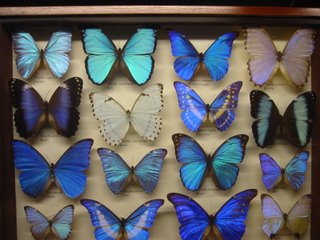
Float like a Butterfly
My classmate’s husband works at the Museum of Natural History, and she was generous enough to ask him to rustle up some free passes to the current butterfly exhibit for Just and me. Maybe because it was such a picture-perfect fall day, or because I had just come from annotating a 12-page John Ashbery poem, but the butterflies (sealed in display cases and fluttering in their humid glass room) seemed like the most deliriously pretty things on Earth. Two of them, brown with circular markings, made me want to drop everything and take up a career in textile design.
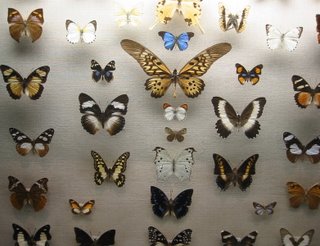
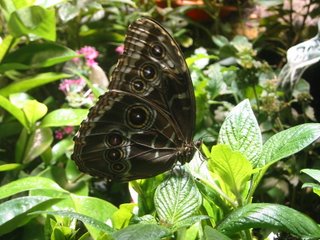

Ain't they purdy? Sorry, by the way, about the infrequent posts lately. I'm trying to make up in photos what I don't have time to produce in words. I’m also working really hard at the moment to impose some kind of structure on my week: school time (reading, tutoring, classes, commuting, and attending the occasional lecture or conference) and non-school time (everything else). So far, it’s working—well, sort of. I’ve gotten into a fairly comfortable 6:30 a.m. tea-and-books routine, and I try to make some time for dinner (Trader Joe's frozen tomales and shrimp must have been invented by an enterprising grad student) and the occasional non-school book; right now I'm reading Cold Comfort Farm, an enormously hilarious novel that you should buy this instant if you don't already own it. In terms of sheer funniness it ranks up there with A Confederacy of Dunces.

Saturday, September 30, 2006
Sleepy Hollow
Last weekend we rented a car and drove upstate, where we happened upon the village of Sleepy Hollow and its churchyard cemetery. A sign out front promised a Halloween reading of the "Legend," and inside the cemetery, we found Washington Irving's tombstone, where I risked my clean criminal record leaping over a low, locked gate to snap a picture. Oh, and just so you know, I tried to persuade the headless horseman to pose, but he thinks he's unphotogenic.
On a way more serious note, I was really moved by the cemetery. Some of the 18th and 19th century graves are passionate and terrible (in the old King James sense of the word) in a way that stoic, contemporary stones just can't touch.

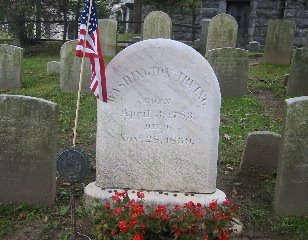




Last weekend we rented a car and drove upstate, where we happened upon the village of Sleepy Hollow and its churchyard cemetery. A sign out front promised a Halloween reading of the "Legend," and inside the cemetery, we found Washington Irving's tombstone, where I risked my clean criminal record leaping over a low, locked gate to snap a picture. Oh, and just so you know, I tried to persuade the headless horseman to pose, but he thinks he's unphotogenic.
On a way more serious note, I was really moved by the cemetery. Some of the 18th and 19th century graves are passionate and terrible (in the old King James sense of the word) in a way that stoic, contemporary stones just can't touch.






Saturday, September 23, 2006
Retail Speak
Doctors and lawyers have their own professional jargons, and it seems to me that retail store employees do as well. When they want you to step forward to the register, they rarely just say “next!” Instead they suck in a lung-full of air and call out, “Will the subsequent guest please make their way directly forward to register six under the green sign on the far right, please!” The sheer number of syllables is supposed to sound polite and professional, but instead it just feels scary. You’re never sure if you’re the one being addressed. “Am I subsequent?” you wonder. And when you finally make it to the register, the cashier barks out cryptic questions and commands: “Who was helping you today?” “Don’t you know that if you buy five pairs of socks, you get the sixth free?” “Credit or debit?” “Press the green button!”
All of this is bad enough, but yesterday I was innocently buying catfood and had a brief exchange with my young, female Petco cashier that, I think, takes the prize for weirdness. I can’t make any sense of it, but maybe you can.
Cashier: Will the following guest please step down!
Jane [placing cans of catfood on the counter]: Hello.
Cashier [smiling]: Hi, how are you today?
Jane: Fine, thanks.
Cashier: Your total comes to $9.89. Do you have a Petco card?
Jane: Well, not yet...
Cashier: Okay, let me just give you this application form. You can fill it out and ret—
Jane: Well, I actually have that form at home. I just haven’t filled it out yet. I’ll bring it in next time.
Cashier: [smiling and shaking her head] I’m gonna strangle you! You better bring it next time!
Jane: [gathering bags hurriedly] Ha, ha! Right!
-----
Help! Is this something people actually say to each other? Am I too old and uncool to get it?
Doctors and lawyers have their own professional jargons, and it seems to me that retail store employees do as well. When they want you to step forward to the register, they rarely just say “next!” Instead they suck in a lung-full of air and call out, “Will the subsequent guest please make their way directly forward to register six under the green sign on the far right, please!” The sheer number of syllables is supposed to sound polite and professional, but instead it just feels scary. You’re never sure if you’re the one being addressed. “Am I subsequent?” you wonder. And when you finally make it to the register, the cashier barks out cryptic questions and commands: “Who was helping you today?” “Don’t you know that if you buy five pairs of socks, you get the sixth free?” “Credit or debit?” “Press the green button!”
All of this is bad enough, but yesterday I was innocently buying catfood and had a brief exchange with my young, female Petco cashier that, I think, takes the prize for weirdness. I can’t make any sense of it, but maybe you can.
Cashier: Will the following guest please step down!
Jane [placing cans of catfood on the counter]: Hello.
Cashier [smiling]: Hi, how are you today?
Jane: Fine, thanks.
Cashier: Your total comes to $9.89. Do you have a Petco card?
Jane: Well, not yet...
Cashier: Okay, let me just give you this application form. You can fill it out and ret—
Jane: Well, I actually have that form at home. I just haven’t filled it out yet. I’ll bring it in next time.
Cashier: [smiling and shaking her head] I’m gonna strangle you! You better bring it next time!
Jane: [gathering bags hurriedly] Ha, ha! Right!
-----
Help! Is this something people actually say to each other? Am I too old and uncool to get it?
Tuesday, September 19, 2006

Someday My Prince (and other fables)
Laura Anne is an eleven-year-old girl from the seaside English town of Siddick who falls in love again and again. But the boys she goes for are almost incidental to this story. After all, they’re just dumb boys, and most several inches shorter than her. It’s not them she cares about. (Well, okay, a little.) But mostly she’s in love with being in love. That’s the premise for Someday My Prince will Come, a short indie documentary directed by Marc Isaacs and narrated in rhyming couplets by Laura Anne, whom the film follows over for a two-year period. I saw it recently at IFC and loved how funny and sad it is, how it draws you in without being the least bit cutesy or knowing. I hope it’s released on DVD so you can see for yourself what a lovely job the director has done.
Seeing it got me thinking about how much I appreciate stories about children-- and why I do. Two of my favorite movies fit this profile: Truffaut’s Small Change and Victor Erice’s The Spirit of the Beehive. I don’t think it’s purely because I’m a sentimental sap. I hate most media portrayals of kids, their use as parrots or props on television, or dolled up on film like fat robots programmed to giggle. Thank God she hasn’t made her way to the screen, but I refer you to the “work” of Anne Geddes, or to those packs of Hollywood cutie pies with just the right hair and lisp. I’m not even really wild about real children (except when they’re related to me—then I’m fanatic).
But from an artistic point of view, stories about children—good stories—provide us with the pleasure of dramatic irony. (Remember back to English class? That’s when we know how the story will end up, but the characters don’t.) For the child, the world at hand is monumental; it’s all she knows. But we’ve been through all that and survived. We know the ending, and it’s our confidence that in all probability she'll also make it through childhood (with its many slings and arrows) that lets us watch with pity and even a kind of protective love. It’s that gap—between her short view and our long one— that gives these stories their enjoyment. We want to save her, not just from hurt, but also from the hopeful melancholy of her innocence, and carry her swiftly to our safe, adult vantage point, though, of course, what we’ve got is no safer. No one, least of all some junior-high prince, flew down and airlifted us out of childhood. So the fictional child has to live through it, too: loved (if she’s lucky) but essentially alone. That’s what the good storyteller does—tells the world as it happens, without trying to fix it. And this is where Peter Pan’s creator J.M. Barrie got it wrong. He wanted to spare his characters from having to grow up, not knowing that for most of us, adulthood is precisely the vantage point we need to make sense of the most wonderful parts of childhood.
Next time I want to talk about a few authors who handle the themes of children and childhood well. So be thinking of books (and movies)! I’m most interested here in how childhood is communicated to adult audiences, though I'd love to hear about any children’s book or movie you love.
Tuesday, September 05, 2006
Crackers!
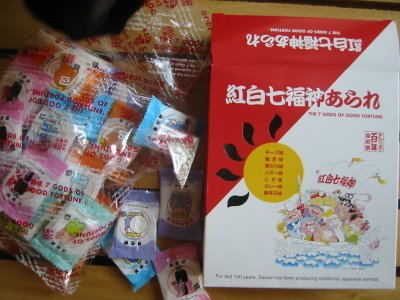
One of my students recently returned from her brother's wedding in Kyoto and brought me a box of Japanese sembei (a.k.a rice crackers). These particular sembei are called "The Seven Gods of Good Fortune," a name that works out to be a tad ungainly in English, but who cares! Each of the teeny, half-dollar size crackers is encased in its own special package, which gives them an unexpected distinction (kind of like carrying each of your pennies in its own separate coin purse). It also drastically slows down the feeding process for those of us used to opening boxes of loose crackers and scooping them to our mouths steamboat paddle-style.
And, surprise! This being a Japanese snackfood, the packaging also allow for an explosion of cute characters. Each package depicts one of the seven happy gods--both front view and rear view (if you flip over the cracker).
Corresponding to the little characters are seven flavors: butter, cheese, shrimp, seaweed, shiso, curry, and hot pepper. I had fun tasting and guessing. Some, like the butter and curry, were obvious from the first whiff. A few others, like the shiso and shrimp, were less recognizable to my Western palate, dulled by years of imbibing Lousiana Hot Sauce.
If ever the NYPD needs a butter-sniffing cat, Bunn will be their man. As I type this, he is nosing around at the open cracker box in search of the fragrant butter cracker, but also trying to see if he can squeeze the entire box over his head. That's his idea of heaven: a box of food blinding his vision while he stumbles around bumping into things. Sounds about right.

Hard at work with another investigation

One of my students recently returned from her brother's wedding in Kyoto and brought me a box of Japanese sembei (a.k.a rice crackers). These particular sembei are called "The Seven Gods of Good Fortune," a name that works out to be a tad ungainly in English, but who cares! Each of the teeny, half-dollar size crackers is encased in its own special package, which gives them an unexpected distinction (kind of like carrying each of your pennies in its own separate coin purse). It also drastically slows down the feeding process for those of us used to opening boxes of loose crackers and scooping them to our mouths steamboat paddle-style.
And, surprise! This being a Japanese snackfood, the packaging also allow for an explosion of cute characters. Each package depicts one of the seven happy gods--both front view and rear view (if you flip over the cracker).
Corresponding to the little characters are seven flavors: butter, cheese, shrimp, seaweed, shiso, curry, and hot pepper. I had fun tasting and guessing. Some, like the butter and curry, were obvious from the first whiff. A few others, like the shiso and shrimp, were less recognizable to my Western palate, dulled by years of imbibing Lousiana Hot Sauce.
If ever the NYPD needs a butter-sniffing cat, Bunn will be their man. As I type this, he is nosing around at the open cracker box in search of the fragrant butter cracker, but also trying to see if he can squeeze the entire box over his head. That's his idea of heaven: a box of food blinding his vision while he stumbles around bumping into things. Sounds about right.

Hard at work with another investigation
Thursday, August 31, 2006
Parenting 101
Overheard tonight:
A young mother climbs on the bus, leading her toddler son by the hand. The little boy has a band-aid on his cheek.
Mother: Look at your face! It look like somebody socked the shit out of you!
Boy: It look like somebody sopped the shit out of me!
Mother: [laughs] No, baby. Not sopped—socked.
Boy: It look like somebody socked the shit out of me!
Mother: Watch your mouth.
Overheard tonight:
A young mother climbs on the bus, leading her toddler son by the hand. The little boy has a band-aid on his cheek.
Mother: Look at your face! It look like somebody socked the shit out of you!
Boy: It look like somebody sopped the shit out of me!
Mother: [laughs] No, baby. Not sopped—socked.
Boy: It look like somebody socked the shit out of me!
Mother: Watch your mouth.
Tuesday, August 29, 2006
From bison to String Theory and beyond
Warning: lost post ahead!
So I went to Fordham yesterday for a long day of orientations and introductions and meetings and preparation for the next few years of doctoral work, and I don’t know what else to say at the moment beyond the fact that I am just downright delighted with all I saw and heard. Of course I didn’t feel delighted while I was there. Frenzied with nervous energy is a more apt description. My resolve to be honest and direct about my feelings about grad school had amounted to me walking around the house all weekend muttering the phrase, “I feel nervous” at regular intervals. To rally my spirits on orientation day, I wore my red platform sandals (see earlier post). I had hoped to shock at least one tweed-wearing person, but not a soul was in tweed, corduroy or even a patched-elbowed blazer, though a few girls wore the requisite lit department whimsical earrings and poetess blouses. A few of the older kids (I mean, the more advanced PhD students) even sported tattoos and bleached blond hair. (Speaking of tattoos, did anyone read David Brooks's silly, irrelevant piece about tattoos in the Times this weekend? I guess there really isn’t anything else going on in the way of global news. Dumb globe.)
Focus, Jane.
The last time I visited Fordham had been at the height of the summer, when the leafy campus was a good ten degrees cooler than the surrounding area. Yesterday it was as foggy, cool and gray as the setting for a Bronte novel. At 8 am, I arrived at the appointed building and found the registration table, where I was given a large Fordham tote bag and a pile of handbooks. I helped myself to some Continental breakfast and proceeded to stand around awkwardly, pretending it was perfectly natural to be spearing grapes from a tiny plastic plate while wearing an oversized red tote bag. Luckily, I soon noticed a woman I sort of know from Hunter, and we hung together happily for the rest of the orientation, talking about Faulkner and school and life and how she secretly doesn’t care much for Jane Austen (“Make up your mind already, Elizabeth!”). She’s entering the program this year also and already knows her dissertation topic: Faulkner through the lens of quantum physics and string theory.
Quelle coincidence! That’s my topic, too!
Err, yeah.
After breakfast, the university president, Fr. McShane, spoke about the school’s history and threw in some juicy factoids about the campus and the surrounding neighborhood, which includes the real Little Italy and the Bronx Zoo. I’ll tell you one very cool piece of trivia, so grab a pen and give it a test run at your next cocktail party: In 1899 after the U.S. had wiped out most of the 50 million bison on the Great Plains, a crew from the Bronx Zoo put together a small herd at the zoo, which was later released into the wild to repopulate the species. Even today, many of the bison you see in western states are descendents of those original Bronx bison!

Fr. McShane then spoke eloquently about the meaning of a Jesuit education, which might be summed up as 1) academic rigor, 2) ethics in and outside the classroom, and 3) respect for the whole person. Not having started classes, I can’t yet attest to the rigor or the ethics, but I am thrilled with how the last factor has played out already. There have been courtesy and sympathy in even in the smallest interactions—from the many faculty members who have offered to answer any question I might have and actually mean it (I’ve already put them to the test) to one of the professors who spoke affectionately of his family and how much he enjoys spending his summers with them. I file away these little moments of humanity, especially after the bureaucracy of CUNY, where individuality amounted to a social security number and a pile of passwords. “Whole person?” I was just another whole person taking up space in an already- crowded elevator or a long line at the registrar’s office (and usually the wrong line, knowing Hunter's helpful, sensitive signage).
The last meeting of the day was the most useful, when the seven or eight of us new PhDs met with the graduate director and the director of job placement, who explained that we should view our graduate work as career preparation, pure and simple. I appreciated this. By this point, we all know books are awesome and reading them is great! We don’t need to sigh over the fate of Tess to remember why we’re here. What I did need to hear— and what I heard to my satisfaction—is that the program will do everything it can to urge (read: boot) me swiftly through the process of courses, comps, and dissertation and, most importantly, help me land a job at the end. Recently, they’ve had a 100 percent job placement rate! Along the way are conferences and research grants, faculty-student reading groups, and the reassuring fact that I’ll be getting a paycheck every two weeks.
So, I’m glad and nervous. The little voice demanding that I justify my decision to go to graduate school has been quieter than usual. He must have heard that I'm now in full possession of a tote-- and I’m prepared to use it.
Warning: lost post ahead!
So I went to Fordham yesterday for a long day of orientations and introductions and meetings and preparation for the next few years of doctoral work, and I don’t know what else to say at the moment beyond the fact that I am just downright delighted with all I saw and heard. Of course I didn’t feel delighted while I was there. Frenzied with nervous energy is a more apt description. My resolve to be honest and direct about my feelings about grad school had amounted to me walking around the house all weekend muttering the phrase, “I feel nervous” at regular intervals. To rally my spirits on orientation day, I wore my red platform sandals (see earlier post). I had hoped to shock at least one tweed-wearing person, but not a soul was in tweed, corduroy or even a patched-elbowed blazer, though a few girls wore the requisite lit department whimsical earrings and poetess blouses. A few of the older kids (I mean, the more advanced PhD students) even sported tattoos and bleached blond hair. (Speaking of tattoos, did anyone read David Brooks's silly, irrelevant piece about tattoos in the Times this weekend? I guess there really isn’t anything else going on in the way of global news. Dumb globe.)
Focus, Jane.
The last time I visited Fordham had been at the height of the summer, when the leafy campus was a good ten degrees cooler than the surrounding area. Yesterday it was as foggy, cool and gray as the setting for a Bronte novel. At 8 am, I arrived at the appointed building and found the registration table, where I was given a large Fordham tote bag and a pile of handbooks. I helped myself to some Continental breakfast and proceeded to stand around awkwardly, pretending it was perfectly natural to be spearing grapes from a tiny plastic plate while wearing an oversized red tote bag. Luckily, I soon noticed a woman I sort of know from Hunter, and we hung together happily for the rest of the orientation, talking about Faulkner and school and life and how she secretly doesn’t care much for Jane Austen (“Make up your mind already, Elizabeth!”). She’s entering the program this year also and already knows her dissertation topic: Faulkner through the lens of quantum physics and string theory.
Quelle coincidence! That’s my topic, too!
Err, yeah.
After breakfast, the university president, Fr. McShane, spoke about the school’s history and threw in some juicy factoids about the campus and the surrounding neighborhood, which includes the real Little Italy and the Bronx Zoo. I’ll tell you one very cool piece of trivia, so grab a pen and give it a test run at your next cocktail party: In 1899 after the U.S. had wiped out most of the 50 million bison on the Great Plains, a crew from the Bronx Zoo put together a small herd at the zoo, which was later released into the wild to repopulate the species. Even today, many of the bison you see in western states are descendents of those original Bronx bison!

Fr. McShane then spoke eloquently about the meaning of a Jesuit education, which might be summed up as 1) academic rigor, 2) ethics in and outside the classroom, and 3) respect for the whole person. Not having started classes, I can’t yet attest to the rigor or the ethics, but I am thrilled with how the last factor has played out already. There have been courtesy and sympathy in even in the smallest interactions—from the many faculty members who have offered to answer any question I might have and actually mean it (I’ve already put them to the test) to one of the professors who spoke affectionately of his family and how much he enjoys spending his summers with them. I file away these little moments of humanity, especially after the bureaucracy of CUNY, where individuality amounted to a social security number and a pile of passwords. “Whole person?” I was just another whole person taking up space in an already- crowded elevator or a long line at the registrar’s office (and usually the wrong line, knowing Hunter's helpful, sensitive signage).
The last meeting of the day was the most useful, when the seven or eight of us new PhDs met with the graduate director and the director of job placement, who explained that we should view our graduate work as career preparation, pure and simple. I appreciated this. By this point, we all know books are awesome and reading them is great! We don’t need to sigh over the fate of Tess to remember why we’re here. What I did need to hear— and what I heard to my satisfaction—is that the program will do everything it can to urge (read: boot) me swiftly through the process of courses, comps, and dissertation and, most importantly, help me land a job at the end. Recently, they’ve had a 100 percent job placement rate! Along the way are conferences and research grants, faculty-student reading groups, and the reassuring fact that I’ll be getting a paycheck every two weeks.
So, I’m glad and nervous. The little voice demanding that I justify my decision to go to graduate school has been quieter than usual. He must have heard that I'm now in full possession of a tote-- and I’m prepared to use it.
Tuesday, August 22, 2006
Revenge of the day-old bread

When I get the urge to make this summery salad, heaven help me if there’s no old bread handy. I'll hang around the kitchen, staring down at the poor fresh loaf until that precise moment when it is officially on its last legs and I can fall on it and begin tearing it limb from limb--or at least into casual one-inch cubes.
Panzanella is its mellifluous name (and a great name for a cartoon princess, don't you think?), though I prefer the more modest sonics of “Bread Salad.” We had it the other night with HA and V at Diner, a place in Brooklyn that I’d just like to step out and call my favorite restaurant in the city. Ha! Whenever I catch myself talking about my favorite things, I feel like my 10-year-old self again, compiling lists of favorite colors, practicing my signature, and resolving once and for all The Question of Which New Kid on the Block is, in Fact, The Cutest. A quick look at my profile will reveal that I haven’t exactly gotten over this tendency.
But, back to the salad. Yesterday morning I realized that there was half a crusty loaf of bread on the counter, so after teaching, I hauled myself down to the Union Square green market and shelled out way too much money on heirloom tomatoes—fine, if you must know, a shocking $10. Lined up like fat toddlers waiting to be adopted, they were impossible to resist, and I had fun selecting tomato after tomato--the more mishapen and odd the better.
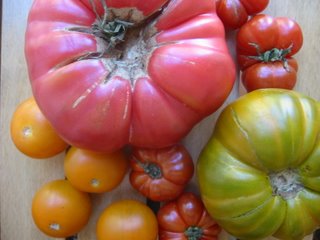 Back home, it took only a few minutes to throw together the salad. We ate it with white wine and miniature farm-fresh strawberries, the latter also purchased in Union Square but at another stand operated by a grim teenage farmer, who accepted my $3.00 skeptically, as if he wasn’t sure he trusted me with his produce. The strawberries look like the kind you see embroidered prettily with leaves and flowers on kitchen curtains, or the ones I remember fondly from this childhood book. Suffice it to say, a single teeny one had more flavor than a bucket of the ordinary kind. Without thinking, I happily exclaimed to Justin, "These strawberries are so small, they're practically the size of berries!" He turned away very slowly, perhaps wistfully thinking what it might be like to be married to a smart person.
Back home, it took only a few minutes to throw together the salad. We ate it with white wine and miniature farm-fresh strawberries, the latter also purchased in Union Square but at another stand operated by a grim teenage farmer, who accepted my $3.00 skeptically, as if he wasn’t sure he trusted me with his produce. The strawberries look like the kind you see embroidered prettily with leaves and flowers on kitchen curtains, or the ones I remember fondly from this childhood book. Suffice it to say, a single teeny one had more flavor than a bucket of the ordinary kind. Without thinking, I happily exclaimed to Justin, "These strawberries are so small, they're practically the size of berries!" He turned away very slowly, perhaps wistfully thinking what it might be like to be married to a smart person.
 Scroll down here for a basic recipe for Bread Salad, which you can adapt as you like. We threw in fresh mozzarella and extra sea salt. Other recipes call for capers, olives or bacon, but that sounded too complex; we wanted to keep it bright--like one of those long, mid-summer evenings.
Scroll down here for a basic recipe for Bread Salad, which you can adapt as you like. We threw in fresh mozzarella and extra sea salt. Other recipes call for capers, olives or bacon, but that sounded too complex; we wanted to keep it bright--like one of those long, mid-summer evenings.
Buon appetito!

When I get the urge to make this summery salad, heaven help me if there’s no old bread handy. I'll hang around the kitchen, staring down at the poor fresh loaf until that precise moment when it is officially on its last legs and I can fall on it and begin tearing it limb from limb--or at least into casual one-inch cubes.
Panzanella is its mellifluous name (and a great name for a cartoon princess, don't you think?), though I prefer the more modest sonics of “Bread Salad.” We had it the other night with HA and V at Diner, a place in Brooklyn that I’d just like to step out and call my favorite restaurant in the city. Ha! Whenever I catch myself talking about my favorite things, I feel like my 10-year-old self again, compiling lists of favorite colors, practicing my signature, and resolving once and for all The Question of Which New Kid on the Block is, in Fact, The Cutest. A quick look at my profile will reveal that I haven’t exactly gotten over this tendency.
But, back to the salad. Yesterday morning I realized that there was half a crusty loaf of bread on the counter, so after teaching, I hauled myself down to the Union Square green market and shelled out way too much money on heirloom tomatoes—fine, if you must know, a shocking $10. Lined up like fat toddlers waiting to be adopted, they were impossible to resist, and I had fun selecting tomato after tomato--the more mishapen and odd the better.
 Back home, it took only a few minutes to throw together the salad. We ate it with white wine and miniature farm-fresh strawberries, the latter also purchased in Union Square but at another stand operated by a grim teenage farmer, who accepted my $3.00 skeptically, as if he wasn’t sure he trusted me with his produce. The strawberries look like the kind you see embroidered prettily with leaves and flowers on kitchen curtains, or the ones I remember fondly from this childhood book. Suffice it to say, a single teeny one had more flavor than a bucket of the ordinary kind. Without thinking, I happily exclaimed to Justin, "These strawberries are so small, they're practically the size of berries!" He turned away very slowly, perhaps wistfully thinking what it might be like to be married to a smart person.
Back home, it took only a few minutes to throw together the salad. We ate it with white wine and miniature farm-fresh strawberries, the latter also purchased in Union Square but at another stand operated by a grim teenage farmer, who accepted my $3.00 skeptically, as if he wasn’t sure he trusted me with his produce. The strawberries look like the kind you see embroidered prettily with leaves and flowers on kitchen curtains, or the ones I remember fondly from this childhood book. Suffice it to say, a single teeny one had more flavor than a bucket of the ordinary kind. Without thinking, I happily exclaimed to Justin, "These strawberries are so small, they're practically the size of berries!" He turned away very slowly, perhaps wistfully thinking what it might be like to be married to a smart person. Scroll down here for a basic recipe for Bread Salad, which you can adapt as you like. We threw in fresh mozzarella and extra sea salt. Other recipes call for capers, olives or bacon, but that sounded too complex; we wanted to keep it bright--like one of those long, mid-summer evenings.
Scroll down here for a basic recipe for Bread Salad, which you can adapt as you like. We threw in fresh mozzarella and extra sea salt. Other recipes call for capers, olives or bacon, but that sounded too complex; we wanted to keep it bright--like one of those long, mid-summer evenings.Buon appetito!
Tuesday, August 15, 2006
In which Jane giddily introduces you to a new blog
Here, friends, is a clever music/recording blog that you should read regularly, even if (and perhaps especially if) you can't tell a ten-channel Yamaha or an Ampex MM1200 from a hole in your head. Studies have shown that ingesting such arcane commentary can build brain cells, forge new neural pathways, and add decades to your life (the equivalent of drinking a quart of wheatgrass and doing a hundred pushups daily).
So read it. Besides, it includes awesome photos of cats!
Aren't you dying now to know who the author is? How'd you like a little hint?
Drumroll, please...
Half the alphabet, no letters repeated, baby!!
You know it! What's up now?
Here, friends, is a clever music/recording blog that you should read regularly, even if (and perhaps especially if) you can't tell a ten-channel Yamaha or an Ampex MM1200 from a hole in your head. Studies have shown that ingesting such arcane commentary can build brain cells, forge new neural pathways, and add decades to your life (the equivalent of drinking a quart of wheatgrass and doing a hundred pushups daily).
So read it. Besides, it includes awesome photos of cats!
Aren't you dying now to know who the author is? How'd you like a little hint?
Drumroll, please...
Half the alphabet, no letters repeated, baby!!
You know it! What's up now?
Sunday, August 13, 2006
Cupcake or Muffin in Disguise? Whatever it is, it's good.
Cupcake Cafe
522 9th Ave
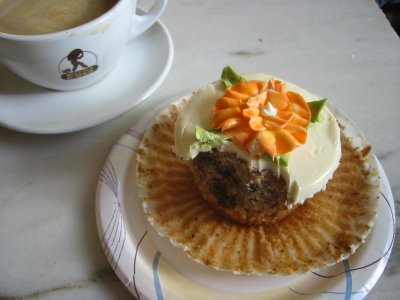
Jane: So you come here a lot, right, because you work in the neighborhood?
Justin: Well, you know this isn't the original Cupcake Cafe. The original one used to be down the street from my work, and this new one's two blocks up, so I don't come here as much.
Jane: Would you say that the cupcakes have changed?
Justin: No.
Jane: How would you describe the cupcakes here, because, to me this is no ordinary cupcake.
Justin: Well, it's not like one of those Magnolia types, topped with sugary frosting.
Jane: Light, spongy...
Justin: Yeah, it's definitely not the kind of cake that falls apart when you take a bite.
Jane: Well, let's talk about the cake first and then the frosting. To be honest, I think the cake, while delicious, is actually more like a muffin.
Justin: I disagree.
Jane: Don't you think it has the density of a muffin?
Justin: Think of a regular muffin. Muffins have a certain set of ingredients...
Jane: Well, it's not a very sweet cupcake, which I think is a point in its favor.
Justin: Right. It doesn't have to be sweet to be a cupcake.
Jane: But don't you think of cupcakes as sweeter and lighter than muffins? Do you want to redefine what a cupcake is?
Justin: No, I don't. I think this definitely qualifies as cake.
Jane: So, it's more about expanding the definition.
Justin:No, listen. This is a walnut cupcake, and so naturally it's a little heartier. You should try the chocolate and yellow cupcakes before making a final judgment.
Jane: No problem. Well, visually anyway, there's no doubt this beautiful thing is a cupcake. Let's talk about the frosting. This frosting is so buttery-- I wonder how much butter they use.
Justin: I'd say it's 90 percent butter.
Jane: Remarkably buttery...
Justin: A lot of people actually complain about that.
Jane: Really? Well, it is a little surprising just how buttery it is.
Justin: Yeah, the cupcakes are all refridgerated right up 'til they're sold, so the flower decorations don't melt.
Jane: So, would you say this is your perfect cupcake?
Justin: I don't know. Maybe the perfect cupcake should always remain elusive.
Jane: Either that, or it's any one that happens to be sitting in front of you.
Stay posted. In our next installment, Justin and Jane tackle the desserts at another NYC bakery.

Cupcake Cafe
522 9th Ave

Jane: So you come here a lot, right, because you work in the neighborhood?
Justin: Well, you know this isn't the original Cupcake Cafe. The original one used to be down the street from my work, and this new one's two blocks up, so I don't come here as much.
Jane: Would you say that the cupcakes have changed?
Justin: No.
Jane: How would you describe the cupcakes here, because, to me this is no ordinary cupcake.
Justin: Well, it's not like one of those Magnolia types, topped with sugary frosting.
Jane: Light, spongy...
Justin: Yeah, it's definitely not the kind of cake that falls apart when you take a bite.
Jane: Well, let's talk about the cake first and then the frosting. To be honest, I think the cake, while delicious, is actually more like a muffin.
Justin: I disagree.
Jane: Don't you think it has the density of a muffin?
Justin: Think of a regular muffin. Muffins have a certain set of ingredients...
Jane: Well, it's not a very sweet cupcake, which I think is a point in its favor.
Justin: Right. It doesn't have to be sweet to be a cupcake.
Jane: But don't you think of cupcakes as sweeter and lighter than muffins? Do you want to redefine what a cupcake is?
Justin: No, I don't. I think this definitely qualifies as cake.
Jane: So, it's more about expanding the definition.
Justin:No, listen. This is a walnut cupcake, and so naturally it's a little heartier. You should try the chocolate and yellow cupcakes before making a final judgment.
Jane: No problem. Well, visually anyway, there's no doubt this beautiful thing is a cupcake. Let's talk about the frosting. This frosting is so buttery-- I wonder how much butter they use.
Justin: I'd say it's 90 percent butter.
Jane: Remarkably buttery...
Justin: A lot of people actually complain about that.
Jane: Really? Well, it is a little surprising just how buttery it is.
Justin: Yeah, the cupcakes are all refridgerated right up 'til they're sold, so the flower decorations don't melt.
Jane: So, would you say this is your perfect cupcake?
Justin: I don't know. Maybe the perfect cupcake should always remain elusive.
Jane: Either that, or it's any one that happens to be sitting in front of you.
Stay posted. In our next installment, Justin and Jane tackle the desserts at another NYC bakery.

Saturday, August 12, 2006
The People's Art
Russian artists Vitaly Komar and Alex Melamid polled Americans to find out exactly what we're looking for in a painting, and, apparently what we want is a dishwasher size landscape featuring a famous historical figure. Check out the resulting paintings from the United States and several other countries.
Komar and Melamid's snarky project is already ten years old, but I just discovered it this morning as a quick aside in Amy Hempel's novella Tumble Home. A poet friend recommended Hempel to me, saying, "Every one of her sentences makes me fall on the floor and weep." When I had finished laughing haughtily over what a great workout that must be, I tore out onto the street and made a flying leap for Barnes and Noble.
Russian artists Vitaly Komar and Alex Melamid polled Americans to find out exactly what we're looking for in a painting, and, apparently what we want is a dishwasher size landscape featuring a famous historical figure. Check out the resulting paintings from the United States and several other countries.
Komar and Melamid's snarky project is already ten years old, but I just discovered it this morning as a quick aside in Amy Hempel's novella Tumble Home. A poet friend recommended Hempel to me, saying, "Every one of her sentences makes me fall on the floor and weep." When I had finished laughing haughtily over what a great workout that must be, I tore out onto the street and made a flying leap for Barnes and Noble.
Friday, August 11, 2006
Too Wussy to go to Afghanistan?
Leave it to Rory Stewart. A 20-something Scotsman, Stewart does what I would certainly do if I had several weeks of vacation to kill: he crosses Afghanistan on foot in the dead of winter. And then he writes an excellent book about it.
Less a historian than a brave, erudite guy with an abiding love for remote places, Stewart dodges land mines, trudges through shoulder-deep snow, and shakes off occasional hostile villagers and packs of wild dogs as he makes his way across the war-torn country in January 2002, just months after 9-11. The book is structured around his daylong hikes and his nights with the Afghan villagers who give him lodging. (Since I'm a sucker for books with pictures, I love that he includes frequent perceptive line drawings of the people he meets.)
The most exciting passages describe Stewart's encounters with hostile villagers, when his survival rests on his courage and verbal dexterity (yep, he speaks the language). There's a riveting scene toward the end of the book when armed Taliban fighters stop him with questions, and he manages to concoct a story convincing enough to save his life.
Last weekend Justin and I went to Jersey to visit friends and spent a few hours splashing around at the beach before settling in to discuss Stewart's book. (It was a real live book club!) We ate fish tacos and sipped peach Sangria, and the conversation was just as good. Jer pointed out that the author's trip falls into the tradition of the privileged British traveler setting out to see the world. Updated for modern times, that archetypical traveler is still a stoic observer with a keen eye, but he no longer plays up the exoticism of alien landscapes for the benefit of those on the homefront. Stewart's reserve translates into a near ban on emotions, excess self-reflection and analysis. All the focus is on what he sees and hears. If this sort of emotional reticence seems off-putting, well, imagine the alternative: having to read about his hurt feelings whenever someone calls him an infidel or serves him stale bread for supper. There are definitely times when I craved more details about his inner life, but, in the end, I have more respect for a book that leaves me a bit hungry.
Oh! And if you're made of the same sentimental mush as me, you should know that a big, loyal dog figures prominently in the story.
Stewart interviewed on Fresh Air.
Leave it to Rory Stewart. A 20-something Scotsman, Stewart does what I would certainly do if I had several weeks of vacation to kill: he crosses Afghanistan on foot in the dead of winter. And then he writes an excellent book about it.
Less a historian than a brave, erudite guy with an abiding love for remote places, Stewart dodges land mines, trudges through shoulder-deep snow, and shakes off occasional hostile villagers and packs of wild dogs as he makes his way across the war-torn country in January 2002, just months after 9-11. The book is structured around his daylong hikes and his nights with the Afghan villagers who give him lodging. (Since I'm a sucker for books with pictures, I love that he includes frequent perceptive line drawings of the people he meets.)
The most exciting passages describe Stewart's encounters with hostile villagers, when his survival rests on his courage and verbal dexterity (yep, he speaks the language). There's a riveting scene toward the end of the book when armed Taliban fighters stop him with questions, and he manages to concoct a story convincing enough to save his life.
Last weekend Justin and I went to Jersey to visit friends and spent a few hours splashing around at the beach before settling in to discuss Stewart's book. (It was a real live book club!) We ate fish tacos and sipped peach Sangria, and the conversation was just as good. Jer pointed out that the author's trip falls into the tradition of the privileged British traveler setting out to see the world. Updated for modern times, that archetypical traveler is still a stoic observer with a keen eye, but he no longer plays up the exoticism of alien landscapes for the benefit of those on the homefront. Stewart's reserve translates into a near ban on emotions, excess self-reflection and analysis. All the focus is on what he sees and hears. If this sort of emotional reticence seems off-putting, well, imagine the alternative: having to read about his hurt feelings whenever someone calls him an infidel or serves him stale bread for supper. There are definitely times when I craved more details about his inner life, but, in the end, I have more respect for a book that leaves me a bit hungry.
Oh! And if you're made of the same sentimental mush as me, you should know that a big, loyal dog figures prominently in the story.
Stewart interviewed on Fresh Air.
Sunday, August 06, 2006
Reading Far Away
The day before we took off for our recent trip to Mexico, a book of poems came in the mail. It was one of those online used book purchases from Amazon that take so long to arrive that when they do show up, you’ve long since forgotten when you ordered them. I’ve had other books take so many weeks that as I crack them open I wonder what could have possibly motivated me to buy them in the first place. This has happened more times than I ought to admit: I look down at the book, and the book stares back haughtily-- “Hey, I don’t know why I’m here either. You’re the one who thought One Hundred Suppers with Lentils would be a good idea. So, here I am. What are you going to do about it?”
I always shelve these books politely. It never occurs to me to send them back.
I didn’t exactly have that reaction to this particular book, The Afterlife of Objects by Dan Chiasson. Ever since I stumbled across one of Chiasson’s poems in a magazine, I’ve wanted to get my hands on the book. The title alone, containing two of my favorite words, “afterlife” and “objects,” would have been enough to sell me. The day we left for Mexico, I threw it in my bag along with a battered copy of The House of Seven Gables. I didn’t have any reason for taking these two particular books except that they interested me at the moment (I wonder if the two of them bothered to get acquainted as they lay squashed together, undignified, in the overhead compartment.) But I also really love these accidental combinations—how books and circumstances can fall together like an unplanned meal. The other night there was nothing else in the house to eat, so we had a supper of Baba Ganoush, roasted red peppers with thyme, and a side of crispy fried tofu with peanuts. Odd, mismatched and too snacky to really count as a meal, but sometimes it works, and it often works well with books. (One notable exception was my idea to pick up Charlie and the Chocolate Factory during a month when I’d decided to give up sugar. I suffered through the book like a martyr but probably gained five pounds anyway just from all the passages about chocolate rivers and candy flowers, etc. )
I wrapped up The House of Seven Gables after we arrived in Oaxaca, and it was—not to gush or anything—really thrilling to read Hawthorne’s long, baroque passages about generational curses and then step into the cramped, pungent aisles of the covered markets. The intricate knots of his characters’ minds, so alien to one another, seemed to hang over my attempts to speak to strangers, and the story’s view of home as a prison you just can’t stand to leave contrasted with a place that eventually seemed familiar and stomach-ache inducing, while home grew more and more elusive, accessible only on the far side of a plane ticket.
By the time I opened Chiasson’s book, we were a few days into our trip, and its cool title had taken on a new significance. The airline had lost our single suitcase somewhere between Houston and Oaxaca, and sitting in our hotel without any of our precious stuff and only a slim volume of poems called The Afterlife of Objects for company, we could appreciate the irony.
Chiasson’s book is fixed on losses, especially ones from long ago. He seems to say that some of the most beautiful objects and moments seem born with their future loss already inscribed in them, like a genetic code. He reaches into the past for objects (kind of like reverse souvenirs), but he avoids any whiff of sentimentality by forfeiting the usual pleasure of nostalgia—that backward-facing soliloquy that allows you to dabble in your old, innocent self, but really, wink, wink, only reveals how much time has passed, how you can never go home again, how you’re a grownup now and you’ve put away childish things but, damn, weren’t things pretty and sparkly back then, and that’s what really matters in the end: the sparkliness of it all.
Thankfully, Chiasson never resorts to this line of thought (which, come to think of it, sort of sums up a lot of Romantic poetry). Instead, he fall into the past in all kinds of odd, jarring and bruise-inducing ways, like a kid who’s had it with the limits of gravity and decides to throw himself backward into a leaf pile, suspecting that it might blow away before he reaches the ground, but not really caring.
Look at how his mind works here:
Spade
I dreamed I was the spade
my mother used
to dig her marigolds in spring,
her bloom and worry.
her digging, throwing, patting to bring
rows to life, each
bloom familiar
to worry, every row perfect, bloom,
rich dirt between, planned
absence and full, superfluous bloom—
I made the trench her hand proposed;
I was the pressure in her palm;
her ache from planting
was
my presence in her life.
Here’s one more. I read this poem several times on the trip and again this morning, and each time it I love it more, and it speaks more fully to the trouble of trying to access the past. It’s a given, I guess, that memories are not fixed places in time that we can visit at will, like points on the map. But the harder thing Chiasson is saying here is that even in the act of speaking or remembering—i.e. writing—the past can’t be retrieved, corralled, explained. At first this seems a blow, a reason for despair, but for me it’s actually unexpectedly reassuring—to think that the past is as itinerant as we are, and as stubbornly resistant to being pinned down.
Poem
When I picture 1940 everyone poses
for me, as though I had the one
camera in the world. I cannot distract them
from their studied, ghoulish jolliness.
My grandmother is posing, yelling
Smile and my grandfather is horsing around
with a tire, making his biceps big. I
can’t know the past, because the past
keeps arranging itself before my lens. People call
out Here and Over here, striking
their prewar, rural, easygoing stances.
That night, when I try again, everyone
is indoors, in parlors, reading quietly.
A woman rocking in and out of lamplight
studies me. The neighbor’s
middle child died this afternoon.
The day before we took off for our recent trip to Mexico, a book of poems came in the mail. It was one of those online used book purchases from Amazon that take so long to arrive that when they do show up, you’ve long since forgotten when you ordered them. I’ve had other books take so many weeks that as I crack them open I wonder what could have possibly motivated me to buy them in the first place. This has happened more times than I ought to admit: I look down at the book, and the book stares back haughtily-- “Hey, I don’t know why I’m here either. You’re the one who thought One Hundred Suppers with Lentils would be a good idea. So, here I am. What are you going to do about it?”
I always shelve these books politely. It never occurs to me to send them back.
I didn’t exactly have that reaction to this particular book, The Afterlife of Objects by Dan Chiasson. Ever since I stumbled across one of Chiasson’s poems in a magazine, I’ve wanted to get my hands on the book. The title alone, containing two of my favorite words, “afterlife” and “objects,” would have been enough to sell me. The day we left for Mexico, I threw it in my bag along with a battered copy of The House of Seven Gables. I didn’t have any reason for taking these two particular books except that they interested me at the moment (I wonder if the two of them bothered to get acquainted as they lay squashed together, undignified, in the overhead compartment.) But I also really love these accidental combinations—how books and circumstances can fall together like an unplanned meal. The other night there was nothing else in the house to eat, so we had a supper of Baba Ganoush, roasted red peppers with thyme, and a side of crispy fried tofu with peanuts. Odd, mismatched and too snacky to really count as a meal, but sometimes it works, and it often works well with books. (One notable exception was my idea to pick up Charlie and the Chocolate Factory during a month when I’d decided to give up sugar. I suffered through the book like a martyr but probably gained five pounds anyway just from all the passages about chocolate rivers and candy flowers, etc. )
I wrapped up The House of Seven Gables after we arrived in Oaxaca, and it was—not to gush or anything—really thrilling to read Hawthorne’s long, baroque passages about generational curses and then step into the cramped, pungent aisles of the covered markets. The intricate knots of his characters’ minds, so alien to one another, seemed to hang over my attempts to speak to strangers, and the story’s view of home as a prison you just can’t stand to leave contrasted with a place that eventually seemed familiar and stomach-ache inducing, while home grew more and more elusive, accessible only on the far side of a plane ticket.
By the time I opened Chiasson’s book, we were a few days into our trip, and its cool title had taken on a new significance. The airline had lost our single suitcase somewhere between Houston and Oaxaca, and sitting in our hotel without any of our precious stuff and only a slim volume of poems called The Afterlife of Objects for company, we could appreciate the irony.
Chiasson’s book is fixed on losses, especially ones from long ago. He seems to say that some of the most beautiful objects and moments seem born with their future loss already inscribed in them, like a genetic code. He reaches into the past for objects (kind of like reverse souvenirs), but he avoids any whiff of sentimentality by forfeiting the usual pleasure of nostalgia—that backward-facing soliloquy that allows you to dabble in your old, innocent self, but really, wink, wink, only reveals how much time has passed, how you can never go home again, how you’re a grownup now and you’ve put away childish things but, damn, weren’t things pretty and sparkly back then, and that’s what really matters in the end: the sparkliness of it all.
Thankfully, Chiasson never resorts to this line of thought (which, come to think of it, sort of sums up a lot of Romantic poetry). Instead, he fall into the past in all kinds of odd, jarring and bruise-inducing ways, like a kid who’s had it with the limits of gravity and decides to throw himself backward into a leaf pile, suspecting that it might blow away before he reaches the ground, but not really caring.
Look at how his mind works here:
Spade
I dreamed I was the spade
my mother used
to dig her marigolds in spring,
her bloom and worry.
her digging, throwing, patting to bring
rows to life, each
bloom familiar
to worry, every row perfect, bloom,
rich dirt between, planned
absence and full, superfluous bloom—
I made the trench her hand proposed;
I was the pressure in her palm;
her ache from planting
was
my presence in her life.
Here’s one more. I read this poem several times on the trip and again this morning, and each time it I love it more, and it speaks more fully to the trouble of trying to access the past. It’s a given, I guess, that memories are not fixed places in time that we can visit at will, like points on the map. But the harder thing Chiasson is saying here is that even in the act of speaking or remembering—i.e. writing—the past can’t be retrieved, corralled, explained. At first this seems a blow, a reason for despair, but for me it’s actually unexpectedly reassuring—to think that the past is as itinerant as we are, and as stubbornly resistant to being pinned down.
Poem
When I picture 1940 everyone poses
for me, as though I had the one
camera in the world. I cannot distract them
from their studied, ghoulish jolliness.
My grandmother is posing, yelling
Smile and my grandfather is horsing around
with a tire, making his biceps big. I
can’t know the past, because the past
keeps arranging itself before my lens. People call
out Here and Over here, striking
their prewar, rural, easygoing stances.
That night, when I try again, everyone
is indoors, in parlors, reading quietly.
A woman rocking in and out of lamplight
studies me. The neighbor’s
middle child died this afternoon.
Friday, August 04, 2006
100 Degrees of Perspiration
WNYC has set up a Flickr photo pool where New Yorkers can post images of the last three days of heat. Here's the slide show. A few of the photos show long lines of coffee lovers waiting for the complimentary iced coffees that Starbucks was handing out yesterday. I left school with a few students to check out the scene at our local S-bucks, but the line was snaking around the block, so we took one look and went back inside. An iced coffee is nice, and a free iced coffee is extra nice, but you only really need one when you've intentionally endured an hour of punishing sunlight and the possibility of heat stroke, waiting for it.
I guess long lines of sweaty people suit Starbucks, since they like to see their customers (myself usually included) falling all over the counter in anticipation; and in the end, it works for the customers, since everybody knows that cold drinks just taste better when you're almost dead. And I can totally understand. Every winter I deliberately try to get frostbite in a few of my toes; it just makes my hot cocoa taste that much better.
WNYC has set up a Flickr photo pool where New Yorkers can post images of the last three days of heat. Here's the slide show. A few of the photos show long lines of coffee lovers waiting for the complimentary iced coffees that Starbucks was handing out yesterday. I left school with a few students to check out the scene at our local S-bucks, but the line was snaking around the block, so we took one look and went back inside. An iced coffee is nice, and a free iced coffee is extra nice, but you only really need one when you've intentionally endured an hour of punishing sunlight and the possibility of heat stroke, waiting for it.
I guess long lines of sweaty people suit Starbucks, since they like to see their customers (myself usually included) falling all over the counter in anticipation; and in the end, it works for the customers, since everybody knows that cold drinks just taste better when you're almost dead. And I can totally understand. Every winter I deliberately try to get frostbite in a few of my toes; it just makes my hot cocoa taste that much better.
Saturday, July 29, 2006
Dog Days
The temperature’s hovering around 95 degrees, and through the back window, the neighbor kids are splashing in an absurdly large plastic pool. One of them hoists a bucket of water over the head of a smaller girl, freezes for a second and lets loose. Squealing and laughter. In a neighboring yard, a middle-aged man sweeps his patio and wipes his forehead, squinting in the sun. Inside, the cats are lazing on the wood kitchen floor like long, open parentheses. It’s almost too hot to write. In the meantime, I’m sipping a glass of this:
Wine Cooler for Grownups
[from "The Splendid Table"]
* Juice of 2 fresh limes
* 1/3 cup sugar
* 1 bottle of light-bodies, fruity red wine, chilled
* Ice
* Lime wedges for garnish
In a large pitcher combine the limejuice and sugar; stir until sugar dissolves. Add the wine and stir. Pour wine mixture over ice in chilled glasses. Garnish with a wedge of lime.
The temperature’s hovering around 95 degrees, and through the back window, the neighbor kids are splashing in an absurdly large plastic pool. One of them hoists a bucket of water over the head of a smaller girl, freezes for a second and lets loose. Squealing and laughter. In a neighboring yard, a middle-aged man sweeps his patio and wipes his forehead, squinting in the sun. Inside, the cats are lazing on the wood kitchen floor like long, open parentheses. It’s almost too hot to write. In the meantime, I’m sipping a glass of this:
Wine Cooler for Grownups
[from "The Splendid Table"]
* Juice of 2 fresh limes
* 1/3 cup sugar
* 1 bottle of light-bodies, fruity red wine, chilled
* Ice
* Lime wedges for garnish
In a large pitcher combine the limejuice and sugar; stir until sugar dissolves. Add the wine and stir. Pour wine mixture over ice in chilled glasses. Garnish with a wedge of lime.
Monday, July 24, 2006

Pistachio butter-cream cookies and an anniversary
These little inventions are a simple sugar cookie topped with pistachio butter-cream frosting and a pinch of crushed pistachios. I nabbed the frosting (only the frosting) from Nigella’s macaron recipe, and used a basic sugar cookie for the base. The VIPs of this cookie are really the pistachios and salt. Without a food processor, I used my coffee grinder to pulverize some pistachios for smooth, creamy frosting. Finally, crushing a few more with a rolling pin and tossing them onto the finished product supplied crunchiness and, according to Justin, “drew out the pistachio-iness of the frosting.”
After some experimentation, I discovered that sprinkling sea salt over the plain cookie resulted in a pleasant salty-sweet taste once I'd slapped on the frosting. I know next to nothing about how ingredients interact during the baking process, and I wondered how the addition of salt at various stages of baking might impact the final product. I played with salting the cookies immediately before or after they went into the oven, though I didn’t bother adding salt to the pre-rolled dough because I wanted to retain that crunchy sea salt texture. Salting beforehand resulted in a slightly warped cookie when compared with the consistently smooth, white results of salting afterward. I didn’t really detect much of a taste difference, and the warped effect may have been caused by some other factor. Sadly, I can’t offer anything really conclusive about the addition of salt to cookies, but would very much love to know more, if anyone happens to have, say, minored in that in college.
Unsurprisingly, this little adventure ended with a massive sugar headache (I don’t recommend baking desserts before breakfast). While I poured myself a fistful of asprin, Justin offered his sympathy and took over as taste-tester. He bit into a cookie, squinted, and chewed skeptically for way too long before pronouncing the thing tasty. It’s good to live with a tough critic, even though at least half the time his judgments make me stomp my feet and pronounce him wrong, wrong, wrong-- at which point he smiles knowingly. I’ve worn a hole in the kitchen floor with all my stomping. As of last Friday, we’ve been married for five years. Laissez les bon temps rouler.
Friday, July 21, 2006
How Body Piercing Saved My Life
I'm only six pages in and already really liking this book. It's always so flattering when someone takes your youthful self as seriously as you did.
I'm only six pages in and already really liking this book. It's always so flattering when someone takes your youthful self as seriously as you did.
Wednesday, July 19, 2006
On shoes and being young
Bringing home a pair of fire engine red sandals the other day from Steve Madden reminded me another shoe shopping trip about a month ago. I was heading out of town on short notice and was in need of a pair of basic walking shoes. I checked a handful of stores without any luck before wandering, with some hesitation, into a chain store known for its comfortable and “therapeutic” women’s shoes. As I entered the store, a nice elderly man with a store nametag held open the door for me. I headed for the displays and had been browsing for a minute when I glanced up and noticed that everyone else in the store—employees and shoppers, every last one of them except me, were senior citizens. I shrugged and went back to shopping but soon started feeling unnerved by the throng of grandmothers quietly browsing around me. Had I missed the sign on the door about a minimum age limit? Now the shoes in front of me appeared in a new light. Heels and sandals that had before looked pleasantly sturdy suddenly seemed aggressively orthopedic. I half expected to see Janet Reno, that tyrant of sartorial practicality, elbowing her way toward the counter and slamming down her AARP card and a pair of oatmeal pumps.
Was I overreacting? Making drama out of something mundane? Well, duh. There are, after all, worse things than discovering one shares the same retail impulses as people over 65. But standing there glancing from the shoes to the customers and back again, I also felt something more personal. I have always had the sense that, though my birth certificate swears I’m only 29, I am at heart going on 80. I’ve always had an affinity for old ladies. I like their circular, patchwork stories, their dreamy complaints and their unexpected ease in their own skin. I like their nostalgia, how they insist on dreaming in reverse when the rest of the world is busy lunging into the future. I think I’m fascinated most by how they risk being lost in that past—something I can deeply relate to, though I can’t say precisely how. In college, my favorite sweater was a grubby white cardigan that resembled nothing so much as a doily crocheted by an angry blind woman and pinched from the back of a Victorian armchair by a dirty-fingered street urchin.
A student once told me that I have “an old soul” and hastened to add that the remark is a compliment. I take it as such. I'm glad my soul is old, but do my shoes have to be?
So there I was in the store, contemplating all this. Meanwhile, shoppers were making their selections, and helpful employees with bifocals and glasses cords were entering and exiting the back room with stacks of shoeboxes. Then the little bell jingled to signal that more customers were entering. The nice greeter straightened up a bit and held open the door for two new arrivals: a pair of wrinkled nuns in their habits, headed straight for the walking shoes.
Bringing home a pair of fire engine red sandals the other day from Steve Madden reminded me another shoe shopping trip about a month ago. I was heading out of town on short notice and was in need of a pair of basic walking shoes. I checked a handful of stores without any luck before wandering, with some hesitation, into a chain store known for its comfortable and “therapeutic” women’s shoes. As I entered the store, a nice elderly man with a store nametag held open the door for me. I headed for the displays and had been browsing for a minute when I glanced up and noticed that everyone else in the store—employees and shoppers, every last one of them except me, were senior citizens. I shrugged and went back to shopping but soon started feeling unnerved by the throng of grandmothers quietly browsing around me. Had I missed the sign on the door about a minimum age limit? Now the shoes in front of me appeared in a new light. Heels and sandals that had before looked pleasantly sturdy suddenly seemed aggressively orthopedic. I half expected to see Janet Reno, that tyrant of sartorial practicality, elbowing her way toward the counter and slamming down her AARP card and a pair of oatmeal pumps.
Was I overreacting? Making drama out of something mundane? Well, duh. There are, after all, worse things than discovering one shares the same retail impulses as people over 65. But standing there glancing from the shoes to the customers and back again, I also felt something more personal. I have always had the sense that, though my birth certificate swears I’m only 29, I am at heart going on 80. I’ve always had an affinity for old ladies. I like their circular, patchwork stories, their dreamy complaints and their unexpected ease in their own skin. I like their nostalgia, how they insist on dreaming in reverse when the rest of the world is busy lunging into the future. I think I’m fascinated most by how they risk being lost in that past—something I can deeply relate to, though I can’t say precisely how. In college, my favorite sweater was a grubby white cardigan that resembled nothing so much as a doily crocheted by an angry blind woman and pinched from the back of a Victorian armchair by a dirty-fingered street urchin.
A student once told me that I have “an old soul” and hastened to add that the remark is a compliment. I take it as such. I'm glad my soul is old, but do my shoes have to be?
So there I was in the store, contemplating all this. Meanwhile, shoppers were making their selections, and helpful employees with bifocals and glasses cords were entering and exiting the back room with stacks of shoeboxes. Then the little bell jingled to signal that more customers were entering. The nice greeter straightened up a bit and held open the door for two new arrivals: a pair of wrinkled nuns in their habits, headed straight for the walking shoes.
Sunday, July 16, 2006
 I named this blog a few months ago, long before it was a full-fledged blog—back when it was just a little blog-twinkle in my eye—because it occurred to me that of all the earthly things I love, two of my most favorite can be reduced to the categories of salt and paper. Salt elevates eating from a ho-hum duty to pure delight (think of a plate of fresh-picked tomatoes, sliced and scattered with salt), and paper is for scribbling and scrumpling, not to mention folding, stitching and binding into books, which in turn can be cracked opened and enjoyed with a piece of dark chocolate or a bowl of salty peanuts. See how it comes full circle?
I named this blog a few months ago, long before it was a full-fledged blog—back when it was just a little blog-twinkle in my eye—because it occurred to me that of all the earthly things I love, two of my most favorite can be reduced to the categories of salt and paper. Salt elevates eating from a ho-hum duty to pure delight (think of a plate of fresh-picked tomatoes, sliced and scattered with salt), and paper is for scribbling and scrumpling, not to mention folding, stitching and binding into books, which in turn can be cracked opened and enjoyed with a piece of dark chocolate or a bowl of salty peanuts. See how it comes full circle?Salt and paper inevitably point to bigger things—a bite to eat with people you love, an empty page for filling, a good read. In that light, food and books will pop up a lot here. I'll sometimes post about what and where I eat, but only if it’s worth sharing. If it’s another supper of black beans and fried eggs, I promise to spare you. This summer I also want to try to document my attempts to make a book. With fear and trembling I recently took a book binding class at the Center for Book Arts, where I studied book anatomy (case-spine, foredge, etc.) and was shepherded through the meticulous process of creating three books of my own (see yonder photo). Now, with even more trembling, I’m going to attempt to duplicate the results at home, though I don’t know how I’ll manage without the Center's heavy book presses and savvy instructor. (Oh, Laurel, where are you when I need you most?). The plan is to make just a simple book to begin. Okay, an extremely simple book. Fine, a piece of notebook paper folded in half with my name written on the front in bubble letters. Care to buy?
Wednesday, July 12, 2006
Tokyo Dylan
I wish every workday were like this.
Typically, my student Hiroyuki meets me on Wednesdays to practice his pronunciation and conversation, but today he surprised me by bringing a guitar to our meeting. In the little cramped classroom he opened the case, tightened the strings, and began to play and sing. I already knew he was a Dylan fan, since we’d spent some time parsing Bob's lyrics (he also loves John Lennon and was a Lennon impersonator back in his high school Beatle Mania club in Tokyo), so I wasn’t surprised when he kicked things off with “Positively Fourth Street” and “Like a Rolling Stone.” While he paused to catch his breath, I hummed a few bars, trying to recall the name of my favorite Dylan number. He guessed right and launched into an awesome, passionate rendition of “Don’t Think Twice, it’s All Right.” Imagine Dylan himself—the precise nasal twang, the tortuous vowels, the sheer persistence of it—but with a Japanese accent. After several more songs, I realized I hadn’t been keeping track of his pronunciation errors or doing anything else particularly teacherly. I’d been too busy singing along like a contented, old drunk.
I wish every workday were like this.
Typically, my student Hiroyuki meets me on Wednesdays to practice his pronunciation and conversation, but today he surprised me by bringing a guitar to our meeting. In the little cramped classroom he opened the case, tightened the strings, and began to play and sing. I already knew he was a Dylan fan, since we’d spent some time parsing Bob's lyrics (he also loves John Lennon and was a Lennon impersonator back in his high school Beatle Mania club in Tokyo), so I wasn’t surprised when he kicked things off with “Positively Fourth Street” and “Like a Rolling Stone.” While he paused to catch his breath, I hummed a few bars, trying to recall the name of my favorite Dylan number. He guessed right and launched into an awesome, passionate rendition of “Don’t Think Twice, it’s All Right.” Imagine Dylan himself—the precise nasal twang, the tortuous vowels, the sheer persistence of it—but with a Japanese accent. After several more songs, I realized I hadn’t been keeping track of his pronunciation errors or doing anything else particularly teacherly. I’d been too busy singing along like a contented, old drunk.
Subscribe to:
Posts (Atom)
